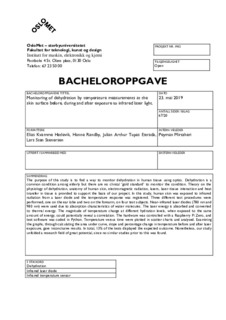| dc.description.abstract | The purpose of this study is to find a way to monitor dehydration in human tissue using optics. Dehydration is a common condition among elderly but there are no clinical ‘gold standard’ to monitor the condition. Theory on the physiology of dehydration, anatomy of human skin, electromagnetic radiation, lasers, laser-tissue interaction and heat transfer in tissue is provided to support the basis of our project. In this study, human skin was exposed to infrared radiation from a laser diode and the temperature response was registered. Three different test procedures were performed, one on the ear lobe and two on the forearm, on four test subjects. Near-infrared laser diodes (780 nm and 980 nm) were used due to absorption characteristics of water molecules. The laser energy is absorbed and converted to thermal energy. The magnitude of temperature change at different hydration levels, when exposed to the same amount of energy, could potentially reveal a correlation. The hardware was controlled with a Raspberry Pi Zero, and test software was coded in Python. Temperature versus time were plotted in scatter charts and analysed. Examining the graphs, through calculating the area under curve, slope and percentage change in temperature before and after laser exposure, gave inconclusive results. In total, 13% of the tests displayed the expected outcome. Nonetheless, our study unfolded a research field of great potential, since no similar studies prior to this was found. | |
